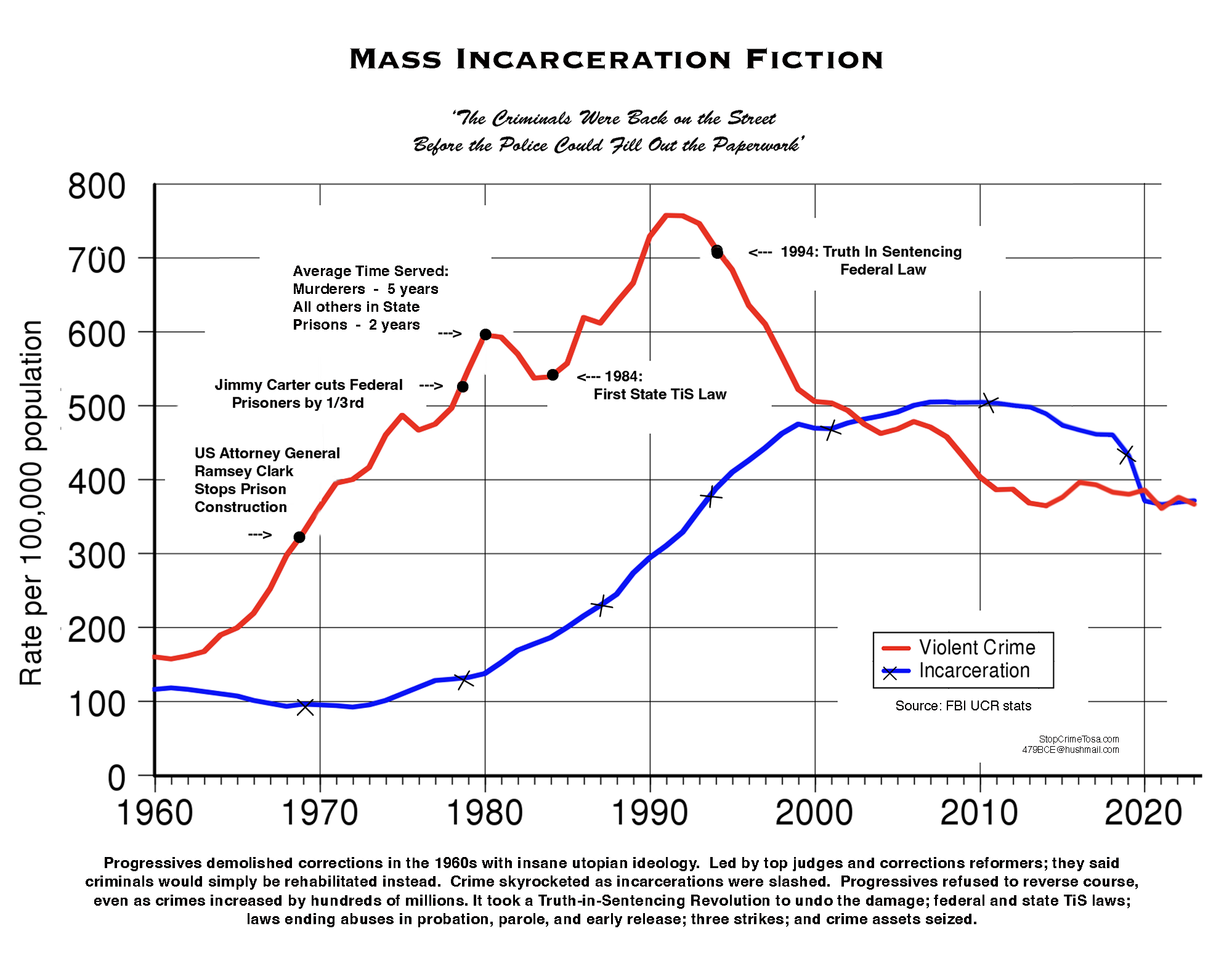Mass incarceration fiction
Over Incarceration is a Myth from the Same Utopians that Sent Crime Skyward
Crime fiction was once popular in dime store novels. Today, it is a progressive industry with annual expenditures of $100s of millions. Decades of world-record failure have only seen it become more powerful. The Sentencing Project, Brennan Center, Vera Institute, Prison Policy Initiative, Equal Justice Initiative, and Harvard Institute to End Mass Incarceration are the same people—the anti-prison utopians—who sent crime skyward in the 1960s. These organizations sit at the top. The Sentencing Project alone has links to 76 other national and 220 state organizations. The Vera Institute alone has assets, expenditures, and revenue of $245 million. The goals are the same: to under cut traditional criminal justice, close prisons, and even claim that probation is overly punitive.
The crime tsunami that started in the 1960s is the biggest ever. Judges, law professors, and intellectuals of the day called prisons dehumanizing, vindictive, primitive, and irrational. Supreme Court Justices called for ‘behavioral scientists’ to rehabilitate criminals. In ‘The Myth of Overpunishment’, Barry Latzer writes, “From the 1930s to the late 1960s... penal reformers dominated... all states were affected by the drive for more lenient policies... probation instead of prison and parole instead of full-term sentences. In fact many of these leniencies became legal mandates, imposed by activist courts." Time Magazine Vol. 100, Issue 4, reports a Wisconsin governor task force’s call to close all prisons, with a federal judge and law professor agreeing. Anti- prison crusader US Attorney General Ramsey Clark, a fixture of the Kennedy/Johnson administrations, blamed society totally; “our inhumanity," and “the sins of generations of selfish neglect.” When the line is crossed, Clark lists 28 reasons why the fountainhead is not the actual criminals. Clark called prisons schools for crime, hothouses that only exacerbate problems and counterproductive. In his 1970 book ‘Crime in America’, Clark says jails manufacture criminals, and imperfect criminal justice is a greater danger than the outlaws. Clark stopped prison construction as all crime categories soared.
The damage was so complete that by the mid-1970s, violent crime had tripled, but incarceration numbers were lower than in 1960. Arrests, convictions, sentencing, and time served continued falling into the 1970s. (Latzer, ‘The Rise and Fall of Violent Crime in America’) In effect, few were going to prison. The universal saying was, ‘The criminals were back on the street before the police could fill out the paperwork.’ The Brennan Center’s ‘History of Mass Incarceration’ explains the crime explosion this way: nothing happened—the 1960s are not mentioned. Same with the Vera Institute’s ‘Causes of Mass Incarceration’, nothing about crime. To talk about incarceration without crime is illogical, but progressives do it all the time. Jimmy Carter did his part; he cut the federal prison population by 34%. With insanity at its zenith by 1980, the real-world maximum prison sentence was five years. The actual time served for murderers was five years; in state prisons, the average actual time served was two years. Criminals did short hitches and hit the streets again.
Any search engine can find lots of incarceration graphs. The Sentencing Project stamps their logo on theirs’. Many graphs are deceptively labeled with raw numbers instead of rates. All crimes are reported as rates so that population differences do not skew the results. Not their graphs. Other graphs show homicide, motor vehicle theft, and burglary against soaring imprisonment. But robbery, assault, etc. are not included, so graphs like that are deceptive, only plotting some crimes against all incarceration. Many graphs start about 1980 at the pinnacle of insanity, normalizing record crime against incarcerations still in the basement, and making that the baseline of some leftist narrative.
The Sentencing Project’s mission statement defies reality. “Increasingly, punitive changes..." comes three decades after the Truth-in-Sentencing Revolution. “Increasing evidence that large-scale incarceration is not an effective means of achieving public safety” follows the triple-digit decrease in every category of crime. “Dangerous prison overcrowding... weighty fiscal burdens... to accommodate a rapidly expanding penal system” does not square up with 12 straight years of falling incarceration and a 20% decline.
The Warren Court-regarded as the nation’s most liberal Supreme Court, a liberal House-Senate- administration, an anti-prison Attorney General, the Great Society, and the Long March Through the Institutions all converged in the 1960s. Understandably, progressives do not want to talk about their total control of government as crime exploded everywhere. Progressives picked up the narrative in the mid-1970s or later when all crime was up by triple digits. At that point every attempt to slow down raging crime over the next three decades is denounced by them, with amazing reverse logic, as somehow contributing to the breakdown.
Violent crime soared 450% from 1960 to 1993. The federal and state incarceration peak from 1960 to 2009 is less. If local jail numbers are included, the peak rate was even lower, at 391%. High crime drove incarceration and leftist policy failure drove the crime. It took hundreds of laws to fix all the holes deliberately punched through the paralyzed corrections system. The Truth-in-Sentencing Revolution cut all crime in half. The Mass Crime disaster since the 1960s is real. The Mass Incarceration claim is a progressive con, a platform that openly pushes racial division and dystopian folly. The progressive narrative is fiction.
